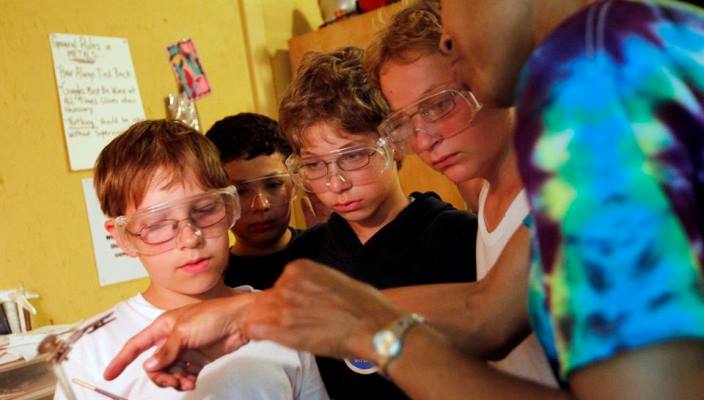
At the beginning of many episodes of his epic Twilight Zone television series, Rod Serling would often intone,
“You are traveling through another dimension, a dimension not only of sight and sound but of mind. A journey into a wondrous land whose boundaries are that of imagination.”
That description could be printed in a brochure or painted on a wall to describe URJ 6 Points Sci-Tech Academy, where imagination, mind, and Judaism were all present this summer as 5th – 10th grade campers energetically and joyfully learned Jewish values while participating in robotics, video game design, web and graphic design, earth and sky, forensics, digital film, and rocketry.
In the course of each day at Governor’s Academy in Byfield, MA, campers were constantly reminded of the goals of camp: sakranut, curiosity; kesher, connection; taglit, discovery;savlanut, patience; and kavod, respect. These values were present in everything they did, including the morning’s “Boker Big Bang” opening, at each meal, in the workshops, in thechugim (workshops), during sports time, and during menucha (rest time).
During robotics, lead instructor Devon added a sixth goal to the mix: g’mishut, flexibility. All day, every day, everyone at camp was constantly reminded of the camp’s unique formula: Science + Judaism = Fun.
Many informally learned a seventh goal: shituf p’ulah, cooperation, and respect for other people’s opinions and ideas. Campers were always together; no camper was ever alone. Those who were considered loners at home because of their special interests or academic abilities worked in partnership with instructors and campers who spoke the same technical language.
Discovery took place everywhere.
As faculty, my role was to be a Reform Jewish role model for the campers and counselors, while bringing them knowledge of Reform Judaism through a morning drash (story) during each day’s opening exercise, during Boker Big Bang (when, yes, stuff was blown up!), through Shabbat service prep, during b’nai mitzvah tutoring, by delivering a d’var Torah on Shabbat morning, by teaching an evening workshop to the counselors and staff (I chose to discuss Jewish identity), by teaching a “Shabbat Shalective” after morning services (I did mine on Golem, Dybbuks, and other Jewish tales), and by having numerous, informal camper-generated conversations.
During these conversations, I learned about the relationship between black holes and quasars (quasars are super massive black holes emitting light from the infall of large quantities of matter), what happens if you displace a point (zero dimension), a line (one dimension), a square (two dimensions), a cube (three dimensions), or a tesseract (a four-dimensional analog of a cube). Rabbi Chanina, the great Talmudic sage, was correct when he said, “Much wisdom have I learned from my teachers, more from my colleagues, and from my students most of all.”
Being in the MIT corridor north of Boston enabled campers to participate in unusual summer camp trip experiences. No amusement parks for this group! The digital film workshop went to New England Film Studios for a firsthand look at an actual sound stage and to learn how professional lighting for films is accomplished. The forensics workshop visited the Boston University School of Medicine; web and graphic design campers toured Microsoft; video game design campers visited Turbine Games (where the campers learned the importance and significance of non-disclosure agreements); and robotics campers visited the robotics lab at Northeastern University. Each group then met at the Museum of Science in Boston and spent the afternoon viewing “The Science Behind Pixar” exhibit.
Even the trip back to camp was treated as a scientific investigation, as the buses were pelted with hail and heavy rain during a freak summer storm. The campers considered it all an experiment and tried to feel the impact of the hail on the bus roof by placing their hands against the ceiling as the downpour hit.
In the videos on the Sci-Tech blog, you can sense the excitement and joy of each camper, all of whom said they were going to urge their parents to let them return. Each 10th grade camper spoke glowingly about wanting to return as machon, counselors-in-training in two years – quite an accomplishment for a camp that had its pioneer season just last summer!
Indeed, although URJ 6 Points Sci-Tech Academy is only in its second year of operation, it functions as though it has been in operation for a decade or more. It is a remarkable place, helping unlock the door to science and Reform Judaism with imagination. It is, as Rod Serling might have said, “a land of both shadow and substance, of things and ideas, a dimension of Judaism and of mind.” And it is most assuredly incredible.
Stephen Weitzman is a member of the URJ North American Board. He is also a member of the North American Camp Commission and serves as the chair of the URJ’s Special Needs Camping Committee. Weitzman is a past president of the URJ – Greater New York Council, has been a religious school teacher at Temple Isaiah in Stony Brook, N.Y., for 35 years, and considers it an honor and a privilege to have been a member of the URJ 6 Points Sci-Tech Faculty in both years of its operation.